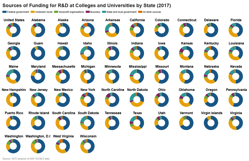
– Winner to be announced during 2019 BioHealth Capital Region Forum –
Five innovative companies focused on the diagnosis or treatment of Multiple Sclerosis, TBI, Autism, Spinal misalignment, and Metastatic Cancer will present their innovative technologies to a panel of judges and industry leaders on April 9th during the 2019 BioHealth Capital Region Forum, at the AstraZeneca campus in Gaithersburg, Maryland. Founded by BioHealth Innovation, Inc. (BHI) and AstraZeneca in 2016, the annual Crab Trap Competition highlights biohealth companies with strong commercial potential. The five finalists were selected from a competitive field of almost fifty entries. The 4th Annual Crab Trap Competition is sponsored by Wilson Sonsini Goodrich & Rosati. The grand prize this year is $10,000.
In 2016, the initial prize was awarded to Sonavex, a commercial stage Johns Hopkins spin-out focused on Empowered Patient Care. The company’s first technology is a dual-component system comprising an FDA-cleared bioabsorbable implant (EchoMark) and an FDA-cleared custom automated ultrasound (EchoSure) to detect post-operative vascular complications prior to catastrophic surgical failures that represent a $3B annual market and cost hospitals up to $577,000 per instance. The company closed a $4.5M Series A in 2018, recently secured a $3M NIH grant and is currently raising its Series B. In 2017, the winner was another Johns Hopkins (JH*) spinout, LifeSprout, developer of a suite of products to address soft tissue needs in the aesthetic and reconstructive markets. Last year’s winner, Galen Robotics, is developing, in partnership with JHU, a surgical robot to make minimally invasive surgeries faster, safer and more precise. The company plans a 510k submission next year, is raising Series A financing, and will be relocating the HQ team in CA to join their engineering experts in Baltimore.
The 2019 BioHealth Capital Region Crab Trap Finalists presenting at the forum at 9:30 a.m. on Tuesday, April 9th, are:
BeCareLink – Predictive Artificial Intelligence Digital Therapeutic Mobile Platform for Multiple Sclerosis and other neurological conditions.
BRAINBox Solutions – Multi-Modality capability to diagnose and provide prognostic information for mild Traumatic Brain Injury.
Floreo Inc. – Leveraging the power of virtual reality to develop a subscription platform that delivers immersive, fun, and affordable lessons for children and adults with autism spectrum disorder (ASD).
Spine Align – Spine Align is a medical device company developing technologies that enable spine surgeons to make real-time intraoperative measurements of spinal alignment.
Unleash Immuno Oncolytics – Developing armed, oncolytic viruses to treat metastatic cancers. Our platform combines tissue-specific control of both viral replication and the expression of human cytokines to provide a dual punch in cancer cells.









